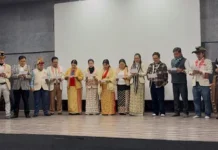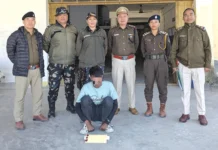[ Dr. Jajati K. Pattnaik ]
The Look East Policy transformed into the Act East Policy under the present political dispensation led by the Prime Minister Narendra Modi has called for a robust and result-oriented diplomacy to attain India’s national interest in its Eastern neighbourhood. The piecemeal approach was supposed to be replaced by a proactive one to steer the course with a renewed spirit to secure tangible results in geostrategic as well as geo-economic term.
Contextualized in Arunachal Pradesh, the policy has generated a lot of optimism among the academia, policy-makers and other stakeholders in the state for a relook at the policy with a new paradigm. Moreover, the Stilwell road which was lost in geo-strategic calculus in the cold war period was accorded prime significance for cross border trade and regional/sub-regional cooperation.
The Chief Minister of Arunachal Pradesh, Pema Khandu is also quite optimistic about the cross border projects and viewed that “implementation of Act East Policy along with improved connectivity will bring rapid economic development in the state.” He informed the Assembly very recently that “state government will revisit the existing state industrial policy to make it more investor-friendly and boost economic growth”. Similarly, the Deputy Chief Minister of Arunachal Pradesh, Chowna Mein said that ‘Act East Policy of Govt of India would be a game changer for the NE states of India vis-à-vis the ASEAN countries.’ Speaking on the occasion of celebration of 25th anniversary of ASEAN-India Dialogue Partnership at Vientiane, Mein said: “Cultural similarity between the people of ASEAN countries and North East India should become the fulcrum of our friendship and the bedrock of all our policies – both diplomatic and economic.”
Stilwell Road
The Stilwell Road, originally known as Ledo Road, is named after the American General, Joseph Warren Stilwell, who undertook the responsibility of constructing the project in December 1942 to open communication links for the Allied forces from India to send reinforcements to Kunming in Yunnan province of China and subsequently free Burma from the clutches of Japanese forces. During its completion in 1944, the road was used as a major supply route for the transportation of arms, troops and other essential materials for Kuomintang Army of China in its war against Japan. The road covering a distance of 1726 kilometers starts from Ledo in Assam (India) and goes across Nampong in Arunachal Pradesh (India) and Shindbwiyang, Bhamo and Myitkyina in Kachin (Myanmar) and further links Ledo-Burma roads junction to the city of Kunming in China. In the present context, the road can be linked with the Southeast Asia as a whole.
The road covers 61 km in India, 1033km in Myanmar and 632 km in China.
Myanmar Government has assigned contract to Yunnan Construction Engineering Group of China and the military backed Yuzana group in 2010 to reconstruct 312 kilometer road from Myitkyina in Myanmar to Pangsau pass at India-Myanmar border. India has renovated its portion of Stilwell road through two lane highways, while China has renovated its own segment through six lane Highways.
The experts working in this field opine that rebuilding of Mytikyina-Pangsau Pass would reduce the cost of transport near about 30 percent benefitting India, Myanmar and China for bilateral as well as multilateral trade. Generally, goods from North East India are brought through road and railways of narrow Siliguri corridor to Kolkata covering near about 1600 kilometer and then transshipped through the Strait of Malacca to South East Asia and China.
The present route takes near about seven days for the landing of cargo whereas the same consignment through Stilwell route can land in Myanmar and China in less than two days. If Myanmar segment is completed, then Ledo-Nampong corridor can be connected to Muse, Lashio, Mandalay and Yangon (Myanmar) through Asian Highway (AH14), Ruili, Wanding and Kunming (China) through AH3 and Bangkok (Thailand), Kuala Lumpur (Malaysia) and Singapore (Singapore) through Asian Highway 2(AH2) and further to Phnom Penh (Cambodia) and Hochi Minh city (Vietnam) of grater Mekong sub-region through Asian Highways 1(AH1).It is envisioned that such type of transnational-connectivity corridors would help in strengthening free trade architecture eventually pave the way for regional and sub-regional cooperation.
Implications
Act East policy through the Stilwell road would reinforce cross border trade in Arunachal Pradesh. The people living across the international boundaries of India and Myanmar have common cultural ties, and it would act as catalyst for cross border trade. Incongruously, Nampong Land Custom Station notified since 1951 remains largely non- functional and the border trade is limited to informal channels. At present, Indian nationals are allowed to visit Pangsau market (Myanmar side) on 10th, 20th and 30th of every month. Likewise, Myanmarese nationals living 16 kilometer of its borer are permitted to visit Nampong on every Friday to purchase their necessary items. However, with the inception of Act East policy and emergence of free trade architecture in the region, the Central Government is considering all possible means to start the formal trade by renovating the Nampong Land Customs Station. In the event of such formal border trade, there would be surge in both imports and exports, and as a consequence, it would strengthen the pace for cross border collaboration involving both hardware and software resources for the benefit of all the stakeholders in the region.
The Stilwell road would give rise to growth triangles in the region. Growth triangles are formed on the basis of different comparative strengths of contiguous regions by capitalizing their natural resources, technology, finance and human for a successful trilateral venture. This concept was originally unveiled by the first Deputy Prime Minister of Singapore Goh Chok Tong in 1989 in the form of SIJORI Growth Triangle which combined the technology and finance of Singapore with that of land, labour and natural resources of Ria Island of Indonesia and Johor of Malaysia. In case of reopening of Stilwell road, there could be possibilities of similar growth triangles such as( a) India, Myanmar and China Growth Triangle, consisting of Upper Assam and Arunachal Pradesh of India, Yunan Province of China and Kachin and Sagaing regions of Myanmar, and ( b) India, Myanmar and Thailand Forum (IMT) consisting of Upper Assam and Arunachal Pradesh of India, Kachin, Sagaing and Mandalay of Myanmar and Maesot of Thailand, based on the amalgamation of their complementary advantages quite similar to SIJORI Growth triangle.
The Stilwell road would promote regional and sub -regional co operation in South and South East Asia.
It would also generate opportunities for Arunachal Pradesh to collaborate with Association of South East Asian Nations (ASEAN), Mekong Ganga Cooperation (MGC) and Bangladesh, China, India and Myanmar (BCIM) forum on trade, transport, technology, automobiles, machineries, electronics, petro-chemicals, gas crackers, pharmaceuticals, herbal, fertilizer, polymer, agro-horticulture, education banking, investment and tourism by harnessing their shared capabilities.
In this connection, it would be noteworthy to point out that special economic zones as well as industrial corridors should be developed in Arunachal Pradesh and the potentialities of the state in (5H) hydro, herbal, horticulture, handicraft and handloom + (2T) tradition and tourism should be explored by tapping cross-border synergies. This proposition would remain a mere utopia unless the economy of Arunachal Pradesh undergoes structural reforms with the free play of the market forces. Before finalizing the roadmap of Look/Act East policy, it is highly necessary that Arunachal Pradesh should come up with specific manufacturing products and earn ‘Make in Arunachal’ image to expand its global reach.
Thus, the need of the hour is to frame action oriented programmes on Act East policy engaging experts from different fields, and then transform them into practice at the ground level for the benefit of all the stakeholders. Otherwise, it would remain a mere rhetoric or purely a wishful thinking. (The writer is an Associate Professor, Department of Political Science, JT Government Model Degree College, Roing, Arunachal Pradesh. He was formerly a Visiting Scholar at the Gulf Studies Programme, School of International Studies, Jawaharlal Nehru University, New Delhi)





